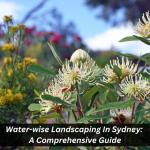
Water-wise Landscaping In Sydney: A Comprehensive Guide
By A1 Bargain Gardening and Landscaping Services|November 14, 2023
In the bustling metropolis of Sydney, landscaping takes on a unique challenge, particularly under the sway of its Mediterranean climate with its blistering, parched summers. To navigate this environmental dance, a thoughtful and strategic approach to water usage is not just advisable; it's imperative. At the heart of this approach lies the crux of water-wise landscaping Sydney – a key methodology for crafting landscapes that not only endure but flourish amidst these challenging conditions.
Benefits of Water-Wise Landscaping
Water-wise landscaping unfurls a myriad of benefits, each contributing to a more sustainable and resilient outdoor environment:
Principles of Water-Wise Landscaping
The principles underpinning water-wise landscaping and low maintenance gardening are both straightforward and impactful:
Sydney's Water-Wise Plant Palette
Sydney's Mediterranean climate, with hot, dry summers and mild, wet winters, provides a perfect environment for a diverse range of water-wise plants. Here is a selection of popular choices:
Trees
Practices of Water-Wise Landscaping in Sydney
Embark on the journey of creating a water-wise landscape in Sydney by adopting these practical practices:
In the vibrant tapestry of Sydney, water-wise landscaping emerges not just as a sustainable but as a pragmatic approach to designing and maintaining outdoor spaces. By adhering to the principles and practices outlined above, you forge a path towards creating a breathtaking landscape that not only survives the challenges of a dynamic climate but thrives, flourishing for years to come. Embrace the beauty of water-wise landscaping, and let your outdoor haven become a testament to sustainability and resilience.
Benefits of Water-Wise Landscaping
Water-wise landscaping unfurls a myriad of benefits, each contributing to a more sustainable and resilient outdoor environment:
- Reduced water consumption
- Improved drought tolerance
- Reduced stormwater runoff
- Improved air quality
- Enhanced wildlife habitat
Principles of Water-Wise Landscaping
The principles underpinning water-wise landscaping and low maintenance gardening are both straightforward and impactful:
- Choose the right plants
- Group plants with similar water needs together
- Mulch to reduce evaporation
- Water deeply and less frequently
- Use an efficient irrigation system
Sydney's Water-Wise Plant Palette
Sydney's Mediterranean climate, with hot, dry summers and mild, wet winters, provides a perfect environment for a diverse range of water-wise plants. Here is a selection of popular choices:
Trees
- Angophora costata (Sydney red gum): A fast-growing, evergreen tree with a spreading canopy and bright red flowers. It is tolerant of poor soils and drought conditions.
- Eucalyptus nicholii (narrow-leaved peppermint): A medium-sized tree with attractive bark and foliage. It is drought tolerant and can be used as a windbreak.
- Corymbia eximia (pink bloodwood): A small tree with a dense canopy and showy pink flowers. It is drought tolerant and can be grown in a variety of soil types.
- Banksia spinulosa (hairpin banksia): A low-growing shrub with bright yellow flowers and serrated leaves. It is drought tolerant and can be grown in poor soils.
- Grevillea robusta (silky oak): A fast-growing shrub with attractive foliage and red flowers. It is drought tolerant and can be used as a screen or hedge.
- Callistemon citrinus (lemon bottlebrush): A medium-sized shrub with showy red flowers and attractive foliage. It is drought tolerant and can be grown in a variety of soil types.
- Kangaroo paws (Anigozanthos spp.): A genus of perennial plants with unique, claw-shaped flowers. They are drought tolerant and can be grown in a variety of soil types.
- Lomandra longifolia (spiky-headed mat rush): A tough perennial grass with long, narrow leaves and spikes of pale yellow flowers. It is drought tolerant and can be grown in poor soils.
- Dianella caerulea (flax lily): A clumping perennial herb with narrow, blue-green leaves and clusters of blue flowers. It is drought tolerant and can be grown in a variety of soil types.
- Dichondra repens (creeping dichondra): A low-growing groundcover with small, heart-shaped leaves. It is shade tolerant and can be grown in a variety of soil types.
- Myoporum parvifolium (creeping boobialla): A low-growing groundcover with small, rounded leaves and clusters of white flowers. It is drought tolerant and can be grown in poor soils.
- Zoysia tenuifolia (Korean velvet grass): A fine-textured turf grass that can be used as a lawn or groundcover. It is drought tolerant and can be grown in a variety of soil types.
- Trees: Acacia baileyana (Cootamundra wattle), Casuarina glauca (swamp oak), and Tristania conferta (brush box)
- Shrubs: Westringia fruticosa (coastal rosemary), Melaleuca thymifolia (honey myrtle), and Eremophila maculata (spotted eremophila)
- Perennials: Gazania rigens (trailing gazania), Agave americana (century plant), and Aloe vera (aloe vera)
- Groundcovers: Portulaca oleracea (purslane), Mentha pulegium (pennyroyal), and Thymus vulgaris (thyme)
Practices of Water-Wise Landscaping in Sydney
Embark on the journey of creating a water-wise landscape in Sydney by adopting these practical practices:
- Design with water conservation in mind: Consider factors like sun exposure, wind patterns, and slope during plant selection and layout planning. This foresight ensures a landscape that harmonizes with the environment.
- Water deeply and less frequently: Instill resilience in your plants by encouraging deep root development through thoughtful watering practices. This method proves invaluable in cultivating drought-tolerant landscapes.
- Use mulch to reduce evaporation: Harness the benefits of mulch to maintain soil moisture and curb evaporation. This simple yet effective practice is a cornerstone of water-wise landscaping.
- Install an efficient irrigation system: For those utilizing irrigation, ensure its efficiency aligns with the unique needs of your landscape. A well-calibrated system prevents wastage and optimizes water usage.
- Maintain your landscape properly: Regular pruning and weeding are not just aesthetic measures; they contribute to the overall health of your plants and reduce water requirements, ensuring your landscape remains vibrant and resilient.
In the vibrant tapestry of Sydney, water-wise landscaping emerges not just as a sustainable but as a pragmatic approach to designing and maintaining outdoor spaces. By adhering to the principles and practices outlined above, you forge a path towards creating a breathtaking landscape that not only survives the challenges of a dynamic climate but thrives, flourishing for years to come. Embrace the beauty of water-wise landscaping, and let your outdoor haven become a testament to sustainability and resilience.



